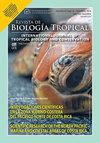哥伦比亚热带干旱林演替梯度的凋落物和养分转移动态
IF 0.6
4区 生物学
Q4 BIOLOGY
引用次数: 0
摘要
摘要:陆地生态系统凋落物生产、叶面养分动态和分解对维持养分循环、土壤肥力和碳调节至关重要。虽然有几项研究解决了这些过程的变化,但由于其生物和非生物因素的复杂相互作用,热带干燥森林(tdf)的动态仍不清楚。目的:评价哥伦比亚托利马TDF演替梯度凋落物量、养分潜力回报和利用效率及其分解变化。方法:对2017年11月至2019年10月12个样地的凋落物进行量化,这些样地分布在4个演替阶段:初生林、早期林、中期林和晚期林。我们确定了凋落叶产生的关键树种,并对这些树种的叶面分解进行了表征。在群落水平上,我们量化了C、N、P的潜在回报、N、P的利用效率以及C:N和N:P比值。在此基础上,分析了植被特征与土壤化学性质之间的关系。结果:后期森林凋落物总量(8.46 Mg ha-1 y-1)是原始森林凋落物总量(4.45 Mg ha-1 y-1)的两倍。初始林(k = 1.28)的分解率高于中间林(k = 0.97)和后期林(k = 0.87)。随着演替的变化,土壤养分势能回报没有变化,但在不同的研究地点之间存在差异。结构发育和物种丰富度有利于凋落物,而土壤化学条件影响养分回报和分解。结论:干扰停止后,tdf可恢复与凋落物和养分动态相关的关键生态系统功能;然而,土壤质量的根本在于回报和释放养分。本文章由计算机程序翻译,如有差异,请以英文原文为准。
Litterfall and nutrient transfer dynamics in a successional gradient of tropical dry forest in Colombia
Introduction: The litterfall production, foliar nutrient dynamics and decomposition are essential to maintain nutrient cycling, soil fertility, and carbon regulation in terrestrial ecosystems. With several studies addressing the variation of these processes, their dynamics in tropical dry forests (TDFs) remain unclear, due to its complex interaction of biotic and abiotic factors. Objective: To evaluate litterfall, nutrient potential return and use efficiency, and decomposition variation in a TDF successional gradient in Tolima, Colombia. Methods: We quantified litterfall from November 2017 to October 2019 in 12 plots distributed in four successional stages: initial, early, intermediate, and late forests. We identified key tree species in foliar litter production and characterized the foliar decomposition of these species. At the community level, we quantified the C, N and P potential return, the N and P use efficiency, and the C:N and N:P ratio. Subsequently, we analyze relationships between vegetation characteristics and some soil chemical properties with these ecological processes. Results: We found that total litterfall in late forests (8.46 Mg ha-1 y-1) was double that found in initial forests (4.45 Mg ha-1 y-1). Decomposition was higher in initial (k = 1.28) compared to intermediate (k = 0.97) and late forests (k = 0.87). The nutrient potential return didn’t change along succession, but it did show differences between study sites. The structural development and species richness favored litterfall, while soil chemical conditions influenced nutrient returns and decomposition. Conclusions: TDFs could recover key ecosystem function related to litterfall and nutrient dynamics after disturbances cessation; however, the soil quality is fundamental in return and release of nutrients.
求助全文
通过发布文献求助,成功后即可免费获取论文全文。
去求助
来源期刊

Revista De Biologia Tropical
生物-生物学
CiteScore
1.80
自引率
0.00%
发文量
23
审稿时长
4-8 weeks
期刊介绍:
The Revista de Biología Tropical / International Journal of Tropical Biology and Conservation is a mainstream scientific journal published since 1953 and covered by Web of Science; Science Citation Index; Current Contents; Google Scholar; Scopus, SciELO and nearly 50 additional indices.
A double blind system guarantees you a fair evaluation, and our world class editorial and scientific boards provides a first decision in three working days. The journal is Full Open Access and is widely read where your article can have the highest real impact.
Since its beginning in 1953, the Revista follows these principles: objective and independent evaluation of all manuscripts; transparency in all processes; ethical use of procedures, data, specimens and subjects; fair treatment of all parties; and absolute predominance of scientific rigor over any other aspect.
 求助内容:
求助内容: 应助结果提醒方式:
应助结果提醒方式:


